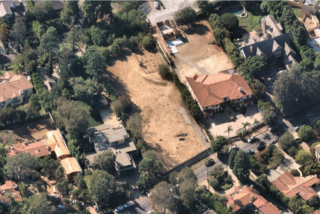Ben Katchor’s askew urban landscape in ‘Hand-Drying in America’
- Share via
Ben Katchor must be the most unlikely comics artist ever to do a newspaper strip. His “Julius Knipl, Real Estate Photographer,” which debuted in 1988, has appeared in papers such as the Forward and the old New York Press, where I first discovered it; to call it idiosyncratic would be to understate the point.
Katchor is an urban visionary, building his stories brick by brick from the detritus of the metropolis: the derelict buildings, the unremembered districts, the flotsam and jetsam of the streets. Born in 1951, he makes comics that bristle with an off-kilter melancholy reminiscent of New York in the 1970s, a city in decline but also oddly full of life.
For Katchor, the character of Knipl is more a guide, like Dante’s Virgil, than a protagonist; in many strips, he appears fleetingly, if at all. The idea is to give us a lens on what Michael Chabon has called, in the introduction to a 1996 collection of Julius Knipl strips, “a crumbling, lunar cityscape of brick and wire that was young and raucous in the heyday of the Yellow Kid.” The Yellow Kid was an early newspaper comic, which is fitting since among the collapsing pillars of Knipl’s city is “a preternaturally limp, gray tabloid” called the Evening Combinator. This is vintage Katchor, to take the familiar, an evening paper, and render it ever so slightly unrecognizable.
Katchor’s new book, “Hand-Drying in America,” operates from a similar set of intentions, gathering 150-plus monthly strips he’s done for Metropolis Magazine since 1998. Because Metropolis covers architecture, the comics here all have design or urban issues at their center, but that just returns us to the city again. This is, as it has always been, Katchor’s vernacular, which makes “Hand-Drying in America” a continuation of his investigations into the psyche, the memory, of urban space.
“Our knowledge of the domestic interiors of a city is limited to the homes of a small circle of friends, acquaintances, and relations,” he tells us in “Open House Season,” a strip on the pleasures of the real estate open house. “We are born, visit a narrow range of apartments, and then die in relative ignorance of how life was lived in our own time.”
Think of “Hand-Drying in America,” then, as an atlas of Katchor’s imaginary city, a series of maps intended to chart its life.
That life revolves, in many ways, around what’s been lost — including newspapers, which appear here as shadows, echoes of another era.
“A building that once housed the offices of the Daily Hubris newspaper is vacant,” Katchor writes in “SayUSaw.com,” “… its readers now get their news from a lively website,” while “The Last Stand” describes how “[with] the demise of print publishing … the city’s newsstands turn to the sale of other merchandise.”
This is one of the most moving strips in the collection, not because it’s a lament for print (it isn’t) but because of how it traces our ability to adapt. “Inexplicably,” Katchor adds, “passersby still gravitate to the near empty stands and huddle beneath their flimsy eaves. … After a day immersed in a reality of pixels and scan fields, they crave the gross physicality of a shack in the street.”
Here we see the core of Katchor’s genius: the blunt language, grossly physical itself, which allows him equally to evoke the surface and to get beneath it, describing a situation and the longing it provokes.
This might also be said of his art, which is schematic, almost architectural, and yet, with its rough pencil lines and broad details, also impressionistic, sketch-like, like a series of snapshots that reveal an astonishing depth.
He uses a set of schematic streetscapes in “From the Outside” to meditate on the relief we feel at leaving buildings. “After eight hours, the coziest room begins to foreshadow the tomb,” he reflects. It’s a telling line, illustrative of the ghosts that reside at the heart of every city, where generations are layered one atop the other, in both our private spaces (who lived here before us?) and the public territory of the street.
If this makes “Hand-Drying in America” sound sad, it isn’t really, although it is certainly bittersweet. Katchor can be funny, and many of his strips have punch lines, although the humor works in subtle ways.
“In a Bad Light” blames the failure of a subway romance on high-intensity illumination: “No one looks good in this light,” he notes. “Orriman Park” considers a developer’s plan to build a park in a business district, an idea derailed by his daughter, who complains, “The midtown of my childhood will gradually be turned into a forest.”
Katchor moves beyond the city altogether in “Cartone Shoes,” taking us to Italy, where a shoemaker “has incorporated the natural surroundings and mild climate of the Apennine Valley into the shoe-buying process,” developing a portico, 3 kilometers long, where customers can take a test walk, often for “the better part of a day.” To make the point explicit, Katchor builds the strip around a large-scale drawing of the portico, zigzagging down the center of the page. It’s a vivid image, absurd in its way, but it gets at one of the key concerns of the collection, which is the loss of grace or elegance in civic life.
In some sense, of course, that’s been Katchor’s subject all along. He’s a poet of the gone world, which lingers, like the vacant offices of the Daily Hubris, whether we notice it or not.
His is an aesthetic of ephemera but an ephemera that transcends itself, in which loss leads to wonder and then, inevitably, back to loss. Perhaps the purest expression of this comes in “The Hall of Pedestrians,” about a museum wing devoted to walking, another retrogressive art.
“In the vast Hall of Pedestrians, a night guard makes his rounds on an electric utility cart,” Katchor observes, tracing a succession of artifacts that somehow echo his whole project, speaking to both the present and the past. “To relieve his boredom, he reads the wall labels. … A Walk/Don’t walk sign, Boston, c. 1980. … A decorative cast-iron-bench from the Avenue des Champs-Elysées, c. 1850. … An audio recording of high heels on a Los Angeles street, 1976. … A slab of bluestone sidewalk from lower Broadway in New York, c. 1977. … A collection of worn heels, Chicago, 1950.”
Hand-Drying in America
And Other Stories
Ben Katchor
Pantheon: 160 pp., $29.95
More to Read
Sign up for our Book Club newsletter
Get the latest news, events and more from the Los Angeles Times Book Club, and help us get L.A. reading and talking.
You may occasionally receive promotional content from the Los Angeles Times.









